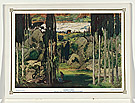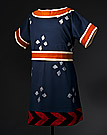Daphnis et Chloé [Daphnis and Chloë]
Choreographic symphony in three scenes
- Producer: Les Ballets Russes de Serge Diaghilev
- Premiere: 8 June 1912, Théâtre du Châtelet, Paris
- Costume design: Léon Bakst
- Costumier: Marie Muelle
- Scenery design: Léon Bakst
- Music: Maurice Ravel
- Choreography: Michel Fokine
- Libretto: Michel Fokine, 1904, after a story by Longus, 200 CE
- Main characters: Chloé (Chloë), Daphnis, Darkon, Lisinion, Lyceion, Briaxis, Lammon, Pan, nymphs, brigands
The ballet takes place on a Mediterranean island, where the shepherd Daphnis and his lover Chloë gather in a grotto with other young people to celebrate the god Pan and his nymphs. Another shepherd, Darkon, and the temptress Lisinion each try to disrupt the pair, to no avail. However, a band of brigands (pirates), led by their chief Briaxis, abduct Chloë. The distraught Daphnis applies to Pan for assistance and the god reunites the pair of lovers by scaring the brigands away. The ballet concludes with celebratory dances by the reunited Daphnis and Chloë.
Daphnis and Chloë, a pastoral novel by the second-century Greek writer Longus, published in Florence in 1598, had sparked Fokine’s imagination as early as 1904, and piqued Bakst’s interest following his 1907 research tour in Greece.4 It was the last of the Ballets Russes’ Greek-themed ballets and shared much of the décor and costume styles of its predecessors Narcisse and L’Après-midi d’un faune. The National Gallery’s costumes are those designed for the ballet’s brigand characters, their simple and abstracted tunic shapes and bold patterning showing a divergence from Bakst’s more familiar decorative Orientalism. Their chequerboard and chevron motifs, stencilled onto woollen fabrics, show the influence of Greek black-figure ceramics on Bakst’s pattern organisation. His close creative collaboration with Fokine meant that these patterns, in vivid colour combinations, would intensify with the asymmetric and angular choreography cutting across his Arcadian setting. Bakst developed some of his Daphnis and Chloë costume designs into a series of ‘fantasies of modern dress’ fashion designs, commissioned in 1912 by the French couturier Jeanne Paquin (1869–1936).











